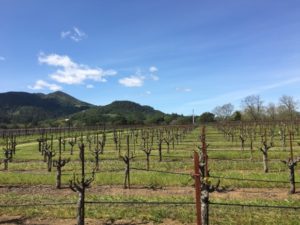 Grapes are among the most intensively managed fruit crops, requiring a great deal of manual labor to complete many production tasks. The declining availability of skilled labor in some grape producing areas is an issue for many growers. With funding from the Agricultural and Food Research Initiative (AFRI) Competitive Program of the USDA National Institute of Food and Agriculture (NIFA), a multidisciplinary research team is assessing the financial outlook for wine and table grape vineyards under the current state of technology, vineyard tasks with potential for robotics application, robotic systems and subsystems, current state of these technologies, and how vineyard labor costs would translate to an equivalent technology price.
Grapes are among the most intensively managed fruit crops, requiring a great deal of manual labor to complete many production tasks. The declining availability of skilled labor in some grape producing areas is an issue for many growers. With funding from the Agricultural and Food Research Initiative (AFRI) Competitive Program of the USDA National Institute of Food and Agriculture (NIFA), a multidisciplinary research team is assessing the financial outlook for wine and table grape vineyards under the current state of technology, vineyard tasks with potential for robotics application, robotic systems and subsystems, current state of these technologies, and how vineyard labor costs would translate to an equivalent technology price.
 Robotic technology offers the potential to duplicate the efficacy of skilled human labor for vineyard tasks requiring selective activity. Today’s industrial robots have dexterity, strength, reliability, speed and precision that is unparalleled by human workers. Wine and table grape production is primed for robotic technology as it faces a variety of production and labor issues that could affect long-term competitiveness.
Robotic technology offers the potential to duplicate the efficacy of skilled human labor for vineyard tasks requiring selective activity. Today’s industrial robots have dexterity, strength, reliability, speed and precision that is unparalleled by human workers. Wine and table grape production is primed for robotic technology as it faces a variety of production and labor issues that could affect long-term competitiveness.
The following is a list of papers and articles associated with the project. If you would like to visit about any of the publications, or other aspects of the project, please contact Drs. McCorkle or Hellman. We are very interested in talking to technology developers who have an interest in developing new technology for vineyards.

Dean McCorkle, PhD. |
The Potential for Robotic Technology for Grape Production in the U.S. (2017) is an article that looks at the economic potential of robotic technology development for vineyards, with the goal of generating interest among technology developers and investors to develop new technology for vineyards. This article also provides a good overview of the project.
Evaluating the Potential for Robotic Technology in California Table Grape Production (2017) is a poster that was presented at the Southern Agricultural Economics Association (SAEA) 2017 annual meeting (Mobile, AL).
Evaluating the Potential for Precision Mechanization in U.S. Wine Grape Production (2016), a paper presented at the Agricultural & Applied Economics Association (AAEA) 2016 annual meeting (Boston, MA).
Evaluating the Potential for Precision Mechanization in U.S. Wine Grape Production Presentation file.
The Potential Applications of Robotic Technology in Wine Production (2018) is a report by RE2, Inc., a robotics company that was a partner on this project. The report provides a detailed explanation of RE2’s findings from the study, including a breakdown of vineyard operations into their individual tasks; existing agricultural technologies, including those in research and development, that could be applied to vineyard operations; a summary of each region we visited; a look at what we consider to be the top markets for the use of robotics in vineyard production; and the technical and economic feasibility and challenges of the use of robotics in grape production.
This research project is supported by the Agricultural and Food Research Initiative (AFRI) Competitive Program of the USDA National Institute of Food and Agriculture (NIFA), grant number 2013-05171.
